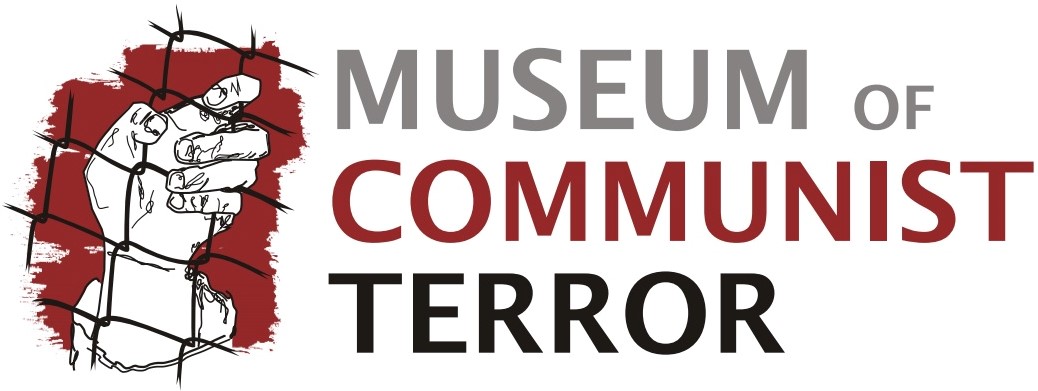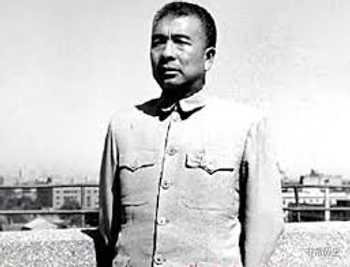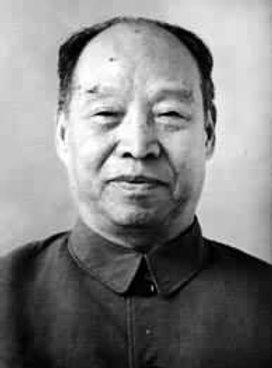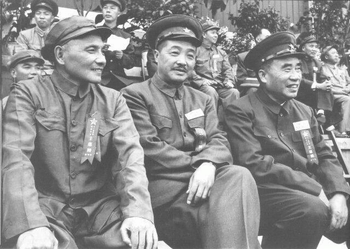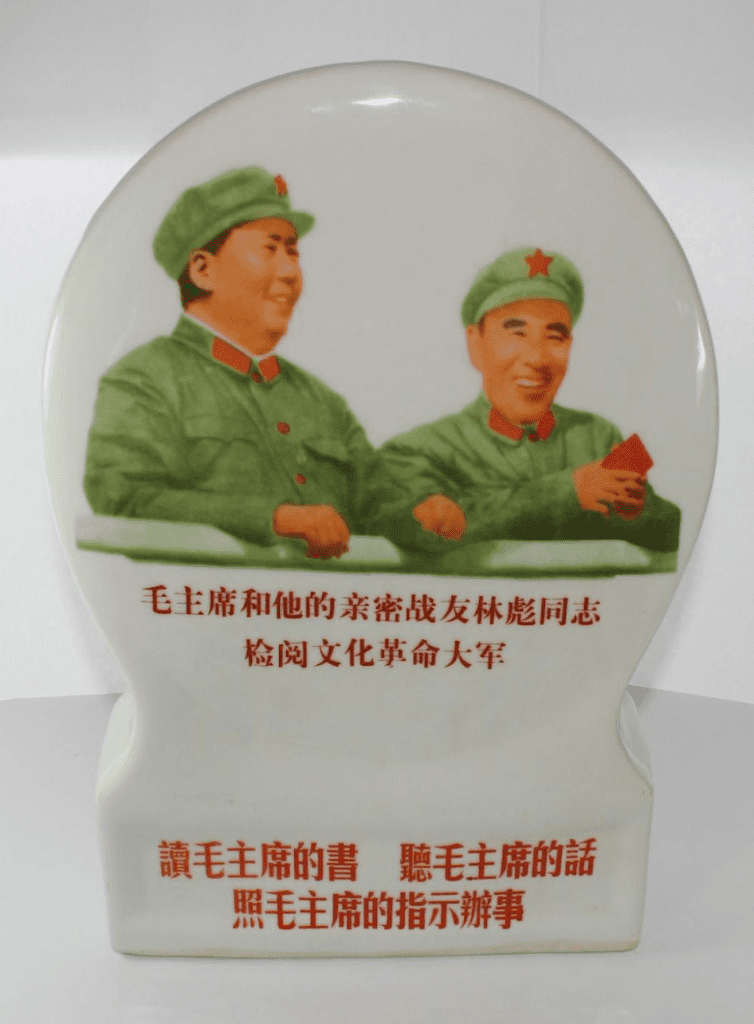The Cultural Revolution was an upsurge in pro-Communist revolutionary agitation against remnants of capitalist or bourgeois thinking in China. The revolution was started in 1966 by Mao Zedong, Chairman of the Communist Party. His reasons are a matter of dispute and conjecture. Ostensibly the aim was to bring purity of ideology back to the Communist Party and the whole population of China. But some have asserted that an important motive was to re-establish Mao’s pre-eminence and power.1 Mao’s prestige had been damaged by the failure of the ‘Great Leap Forward’ which he had instigated in 1958. Farms has been collectivised and production of steel had been made a countrywide priority. This policy had led to widespread famine estimates of the resulting deaths are between 23 and 55 million.2 The Cultural Revolution enabled Mao to reassert his status and to demote or destroy political rivals, such as Deng Xiaoping, General Secretary of the Secretariat, and Liu Shaoqi, President of the People’s Republic of China.3 (For more about the senior rivals and opponents Mao purged, see the list below.)

Chairman Mao Zedong
The Cultural Revolution began in 1966, following the release of the ‘May 16 Notification’, endorsed by Mao. The ‘May 16 Notification’ stated that the Communist Party had been infiltrated by counter-revolutionaries and revisionists. Newspapers urged the masses to ‘clear away the evil habits of the old society’.4 Students and school children had been brought up to revere Mao and they responded to his call. Student groups who supported Mao became known as ‘Red Guards’ and were encouraged to model themselves on military units.5 In August 1966, Mao encouraged the Red Guards to destroy ‘old ideas, old customs, old habits and the old culture of China’.6 School classes stopped and Red Guards raided private homes and ransacked shrines, libraries and shops. Red Guards removed or destroyed anything considered bourgeois, as well as anything connected to the Kuomintang, the rival force that had been beaten by the Communist Party in the civil war (1927-1949, interrupted by the Japanese invasion during 1937-1945).
People had been divided into “Reds”, “Blacks” and “Greys” prior to the Cultural Revolution but the division was taken much more seriously once the Cultural Revolution started.7 “Reds” were people from working class backgrounds or families who had taken part in the Communist revolution. “Blacks” were from professional or bourgeois families as well as those who had sided with the Kuomintang or done anything to cast doubt on their loyalty to the Communist Party. “Greys” were in between. People could be defined as “Grey” even if they were only office staff or shop assistants.8 Children were defined as “Red” “Black” or “Grey” according to the status of their parents.
Once the Cultural Revolution was under way, “Reds” were told to shun “Blacks” even if they had previously been friends.9 If they did not, they might be accused of not being truly “Red” themselves. Homes of the “Blacks” were raided and the owners were often subjected to “denunciation meetings” (also known as “struggle sessions”) where they would be made to kneel and were kicked and beaten with belts with metal buckles at the end.
Jung Chang, whose autobiographical book Wild Swans includes chapters on her family’s experience of the Cultural Revolution reported that her mother was subjected to about 100 such denunciations, some of them in front of crowds.10 Her mother was repeatedly told to denounce her husband but refused.11 Some people died from the beatings and torture. Pressure on children to “draw a line” between them and their condemned parents was intense and many did so. Some changed their surnames. Some did not visit their parents in detention and some even took part in denunciation meetings against their own parents.12 Suicide was quite common by people who did not want further beatings and torture, especially if their families had succumbed to pressure to denounce them.13
Red Guards waved and quoted from “The Little Red Book”, a selection of quotations by Mao. Public readings of these quotations took place in squares, on buses or were even preached in the sky by air hostesses on planes.14 Mao prohibited the nation’s security forces from interfering with the violence of the Red Guards. The Cultural Revolution affected every aspect of life. Tea houses, a traditional part of Chinese life, were closed.15 All songs were banned except ones consisting of quotations from Chairman Mao or else in praise of him.16 Wearing make-up or decorative clothes could put someone in danger of denunciation.

Red Guards waving the Little Red Book in a School Class
After the first few months, workers joined the fray. Some revolted against the Party cadres in charge of the factories.17 In October 1966, Mao encouraged this, calling on the masses to “educate and liberate themselves”.18 Red Guards harassed embassies even including that of the USSR – a fellow Communist country. As many as million people took part in besieging embassies, unfurling giant portraits of Mao and shouting insults with loudhailers. They torched the British mission almost burning the diplomats alive.19
A new phase of the Cultural Revolution began that October when, with Mao’s endorsement, anger was turned on “capitalist roaders” and “counter-revolutionary revisionists” within the Communist Party’s own ranks.20 Those who rose up to oppose officials within the Communist Party were known as “Rebels” and those in the party who tried to resist have been referred to as “Royalists”.21 In the view of Jung Chang, “The Rebels’ basic assignment was to punish Party cadres, which is what Mao had been longing to do for years.”22 But to complicate matters, rival groups of “Rebels” formed themselves and competed for power. They fought each other using whatever weapons they get their hands on in order to control cities and regions.

Chairman Mao’s third mass rally out of eight
Another new phase began when Mao called in the army in January 1967. He had put in Lin Biao as defence minister and he did not trust the security service which had been built up by Luo Ruiqing. Luo Ruiqing was publicly vilified by Red Guards for two days on January 4th and 5th 1967, and forced into the ‘jet plane’ position in which his arms were twisted backward.23 On 11th January, soldiers with machine guns started appearing in banks and thereafter in other key places.
But in February 1967, some of the top military officers condemned the Cultural Revolution and took steps to stop the violence.24 Mao arranged for mob attacks on these military commanders and those members of the politburo who had supported them. They were subjected to house raids and denunciation meetings. The opposition was squashed. This episode has been called the “February Adverse Current”.25
Mao also found a different way to exercise control. He sent delegates to the provinces to set up “Revolutionary Committees”.26 Mao wanted the membership of the committees to have three components: the local army; representatives of the Rebels and “revolutionary officials” who were selected former administrators.27 Mao used the committees to bypass the control of the Communist Party in local areas. In the central government, Mao effectively replaced the control of the Politburo with the ‘Cultural Revolution Authority’.28 Lin Biao used the opportunity, as one of Mao’s trusted men, to purge the army of disloyal commanders, taking command of the Central Military Committee through his own personal office and controlling it through his wife. Mao’s began to exercise control through a cabal “like a medieval court, structured around wives, cousins and fawning courtiers”.29
The fighting between various factions led to mass killings in areas such as Yunnan and Hunan, with the largest number of killings in Guangxi.30 Zhou Enlai, the prime minister, and Lin Biao, First Vice Chairman of the Communist Party, each attempted to place their own men in control of the region. In the end, Mao indicated that he favoured the faction supported by Zhou Enlai. Its leader, Wei Guoqing was given permission to do what he needed to re-establish order in the province. By the end, some 80,000 people had been killed.31 According to Frank Dikötter, “So many bodies were strewn across the city [of Nanning] that corpses were tossed into coal mines and ditches.”

Denunciation Meeting/Struggle Session
Sampho Tsewang Rigzin and his Wife
Methods of torture of those who were denounced varied. Jung Chang’s mother was made to kneel in cold water in winter for hours until she passed out. Twice she was put on a “tiger bench”. This meant her thighs were tied to a narrow bench so that her legs went out along it. Her torso was tied to a pillar. Bricks were forced under her heels. “The intention was to break the knees or the hip bones.”.32 Zhang Linzhi, the Minister of Coal, who had previously criticised Mao and the Great Leap Forward, was one of the senior figures who was “jet-planed”. Another time he was pushed onto a bench and cut with small knives. Finally an iron stove was attached to his head, pulling it down to the floor and “his head was bashed in with heavy brass belt buckles”.33
Food was in short supply.34 In some areas there was famine and people ate whatever they could find, even resorting to cannibalism.35
In December 1968, another new phase began. Students were instructed to leave the cities and go to rural areas where they were told they could learn from peasants. Millions of young students left cities for the countryside over the next decade.36 Many went with great enthusiasm. Some were very disappointed by the reality of life in remote areas. Many did not have a roof over their heads.37 Others resisted going or found ways to avoid it.
Between 1971 and 1976, the intensity of the Cultural Revolution eased. In 1972, both Mao and his right-hand, Zhou Enlai had serious health problems. They agreed to bring back Deng Xiaoping who had been purged from the Communist Party earlier in the Cultural Revolution. Deng faced fierce opposition from Mao’s wife Jiang and her allies who had been at the heart of the Cultural Revolution. They became known as ‘The Gang of Four’. For three to four years, Chinese politics swayed between the two rival camps. The Gang of Four seemed to have won when Zhou Enlai died and the Gang of Four convinced Mao to purge Deng. But, in 1976, Chairman Mao died and a civil, police and military coalition pushed the ‘Gang of Four’ out of power. Deng Xiaoping was rehabilitated in 1977 and became the effective leader, despite not being the chairman of the Communist Party or head of state.38 Jiang was sentenced to death but the sentence was commuted to life imprisonment.39
In 1981, the Communist Party officially declared that the Cultural Revolution had been a mistake.40 The Communist Party downplayed Mao’s role and placed the blame on Lin Biao, First Vice Chairman of the Communist Party, and Jiang Qing, Mao’s wife.41 The 1981 condemnation refers to the Cultural Revolution as the cause of “domestic turmoil” which “brought catastrophe to the party, the state and the whole people”.42 Discussion of the event more recently has been limited. In 2016, the 50th anniversary of the start of the Cultural Revolution, there were no ceremonies or commemorations. The Communist Party paper, The People’s Daily, carried an editorial about it on page four which said: “History has shown that the Cultural Revolution was utterly wrong, in both theory and practice”.43
Estimates of the number of people who died as a result of the Cultural Revolution vary enormously. The most common estimates are between 750,000 and 2 million but the full range of estimates is from 400,000 to 20 million.44
My mother was sitting on the edge of their bed, and my father was in a wicker chair opposite. He told her that he now knew what the Cultural Revolution was really about, and the realization had shattered his whole world. He could see clearly that it had nothing to do with democratization, or with giving ordinary people more say. It was a bloody purge to increase Mao’s personal power.
Jung Chang, Wild Swans, p 416. Her father was a committed Communist and a senior official prior to the Cultural Revolution.
____________________
Prominent opponents or rivals purged by Mao during the Cultural Revolution
According to Philip Short (The Dragon and the Bear pg 178), the ‘four principal victims’ who Mao purged in the Cultural Revolution were:
President of China, ranked second in the hierarchy to Mao himself. He was “the man he [Mao] hated most” (Mao, The Untold Story p. 641). He had implicitly criticized Mao when he said that the failure of the “Great Leap Forward” was 70 per cent due to human error (Wild Swans p. 285). He opposed the Cultural Revolution. He was denounced as “China’s Khrushchev” (ie someone who deviated from pure revolutionary Communism) and a U.S. spy (Wild Swans p339 and 626). In January 1967, his home was surrounded and he and his wife were made to stand on a table where they were harangued by Red Guards. Soon after their telephone was cut off. (The Dragon and the Bear pg 176.) He was detained and experienced ferocious beatings at denunciation meetings. Knowing that much of his strength came from his relationship with his wife, Mao arranged for them to be put in separate virtual solitary confinement (Mao, the Untold Story p. 646). The Lius were punched, kicked and “jet-planed”. Liu was trampled on the ground. His six-year-old daughter and other children were brought in to watch the assaults (Mao, the Untold Story p. 647). He became seriously ill with diabetes and pneumonia. Denied proper medical treatment, he died a slow, agonizing death in November 1969.
Head of the propaganda department and party chief in South China. He was promoted to be the fourth ranking member of the politburo at the beginning of the Cultural Revolution. Then he resisted the extremes of the Cultural Revolution. He was detained in inhuman conditions for three years and his health deteriorated. He was denied proper treatment until his gallbladder cancer was advanced and Zhou Enlai sanctioned an operation (Wild Swans, p. 494). The windows of his hospital room were permanently blacked out with newspapers. When he was removed from Peking in 1969, his wife was given the choice either to accompany him and lose all ties with their daughter or stay with her daughter and leave him to die alone. She chose to stay with her daughter. Six weeks after they parted, he died (The Dragon and the Bear pg 178).
General Secretary of the Communist Party. He was sent to work in a tractor factory. His son, Deng Pufang, was tortured and either jumped or was thrown out of a second floor window and became paralysed from the waist down. Later Deng was rehabilitated (Wild Swans p285). It has been suggested that he was regarded as a competent administrator and that even Mao recognized that the economic damage of the Cultural Revolution had gone too far. After he was re-habilitated, he was still opposed by the “Gang of Four” but in due course he became the most powerful man in China.
Mayor of Peking and Peking first party Chief. He criticised the Great Leap Forward. He later allowed publication of a play which Mao considered to be hostile to him. Peng was removed from his position and harassed by Red Guards (https://alphahistory.com/chineserevolution/peng-zhen/). He was imprisoned in Qincheng where conditions were severe (The Dragon and the Bear, pp.182/3). In 1975, political conditions eased and he was exiled to the country. He was rehabilitated in 1979.
Many others were purged. These are a few of the other prominent ones:
Lin Biao
He was made Mao’s number two at the beginning the Cultural Revolution and was a key figure in getting the army to support Mao. He built up the cult of Mao. But Mao began to perceive him as rival for power (Mao, the Untold Story p. 671). In 1971, Mao moved against him. Lin decided to try to escape by plane. There has been some uncertainty about what then happened but according to Jung Chang and Jon Halliday, Lin did not have time to refuel the plane fully and it crashed in Mongolia killing all nine passengers (ibid p. 681).
Different authors use one of two different ways of transcribing Chinese names: Hanyu Pinyin and Wade-Giles. These are the two versions of the some of the names mentioned above.
Mao Zedong = Mao Tse-tung
Zhou Enlai = Chou En-Lai
Deng Xiaoping = Teng Hsiao-p’ing
Liu Shaoqi = Liu Shao-ch’i
Tao Zhu = T’ao Chu
Peng Zhen = P’eng Chen
Lin Biao = Lin Piao
Marshal Peng Dehuai = P’eng Te-Huai
Marshal He Long = Ho Lung
_______________________
1. Chang, Jung and Jon Halliday, Mao: The Unknown Story (London, 2005), p. 130.
2. Dikötter, Frank. Mao's Great Famine: The History of China's Most Devastating Catastrophe, 1958–62 (London,2010), Pg. 333. Dikötter’s is the most recent estimate at the time of writing. He states that a minimum of 45 million people died.; Becker, Jasper, Hungry Ghosts: Mao's Secret Famine, (New York, 1998), Pp. 270 & 274. Becker gives the figure of 30 million. For the full range of estimates, see https://en.wikipedia.org/wiki/Great_Leap_Forward#cite_ref-55 (accessed 13 th March 2020).
3. Chang, Jung, Wild Swans (London, 2004), Pp. 493-5.:
4. Phillips, Tom, ‘The Cultural Revolution: all you need to know about China's political convulsion’, in The Guardian, 11 May 2016. https://www.theguardian.com/world/2016/may/11/the-cultural-revolution-50- years-on-all-you-need-to-know-about-chinas-political-convulsion
5. Dikötter, Cultural Revolution, p. 71-80: Dikötter describes the rise of the Red Guards.
6. Dikötter, Cultural Revolution, p. 74.
7. Interview with Amy Li by James Bartholomew in Sydney, October 2018 re the status of Reds and Blacks existing before the Cultural Revolution and becoming much more important during the Cultural Revolution. Dikötter, The Cultural Revolution p. 105 “the first question in China was always “What is your class background?””; Chang, Wild Swans p. 367 about an earnestly pro-Communist youth who had been categorised as “Black”: “In the last couple of days she had been put under guard and forced to pull grass out of the sports ground.”; p. 379 “When I saw the ‘blacks’ and ‘greys’ having to clean the toilets and the grounds their heads bowed, a creeping dread came over me…”
8. Chang, Wild Swans, p. 366.
9. Interview with Amy Li by James Bartholomew in Sydney, October 2018.
10. Chang, Wild Swans, p. 450.
11. Ibid p. 453.
12. Ibid p. 457.
13. Ibid p. 449.
14. Phillips, ‘The Cultural Revolution’ article in the Guardian referred to above.
15. Chang, Wild Swans p. 415.; “Relaxation had become an obsolete concept: books, paintings, musical instruments, sports cards, chess, teahouses, bars – all had disappeared.”
16. Ibid p. 391.
17. Dikötter, Cultural Revolution p. 121.
18. Dikötter, Cultural Revolution p. 122.
19. Chang and Halliday, Mao, p. 692. In 1967, numerous foreign missions were besieged, not just western countries, but also that of the Soviets and North Koreans.
20. Dikötter, Cultural Revolution, p.116.
21. Dikötter, Cultural Revolution, p.118.
22. Chang and Halliday, Mao, p. 635.
23. Dikötter, Cultural Revolution, Pp. 128/129.
24. Chang, Wild Swans, p. 418.
25. Ibid p. 419.
26. Ibid p. 419.
27. Ibid p 423.
28. Dikötter, Cultural Revolution, p. 419.
29. Chang, Wild Swans, p 419.
30. Dikötter, Cultural Revolution, p. 175.: Dikötter is citing information presented by Shen Xiaoyun, in his work, “The Revolutionary Committee Grows out of the Barrel of a Gun During the Great Proletarian Cultural Revolution: The Unknown Truth of ‘Armed Conflict’ in Guanxi”, in Modern China Studies, 20, no. I (2013), Pp. 141-82.: for the other massacres see: Song, Yongyi, ‘Chronology of Mass Killings During the Chinese Cultural Revolution: 1966-1976’, in SciencesPo Mass Violence and Resistance – Research Network, 25 August 2011.; Hecheng, Tan, The Killing Wind: Achinese Country’s Descent into Madness During the Cultural Revolution (Oxford, 2017).
31. Dikötter, Cultural Revolution, p. 176.
32. Chang, Wild Swans, Pp.452-3.
33. Chang and Halliday, Mao, p. 636.; Short, The Dragon and the Bear, p. 179
34. Chang, Wild Swans, p. 456. “Nearly everything from salt, toothpaste, and toilet paper to every kind of food and clothing was rationed or disappeared completely. In Chengdu there was no sugar for a year, and six months passed without a single bar of soap.”
35. Phillips, ‘The Cultural Revolution’ article op. cit.; Zheng, Yi, Scarlet Memorial: Tales of Cannibalism in Modern China (Boulder, 1996), p. 198.: Zheng asserts that the cannibalism was systematic though this is challenged by other scholars such as Gang Yue in ‘The Mouth That Begs: Hunger, Cannibalism, and the Politics of Eating in Modern China (Duke, 1999), Pp. 228-30. Yue states that it is difficult to say that cannibalism was systematic, given the factionalism at play. However, the conditions of factionalism, anarchy, and hunger provided the conditions in which some level of cannibalism took place, whether systematic or not.
36. Dikötter, Cultural Revolution, p. 192.
37. Dikötter, Cultural Revolution, p. 195.
38. Deng effectively became the ‘Paramount Leader’ of China, an informal position.; Watkins, Thayer, The Career of Deng Xiaoping, San Jose State University Department of Economics, http://applet-magic.com.p11.hostingprod.com/deng.htm. “1977, Deng returned to all his official positions and in addition he was the chief of staff of the People’s Liberation Army. Deng’s leadership was not a result of the formal offices he held but instead from a consensus among the top leaders to follow his lead, although it did not hurt for him to have control of the army. In the power struggle between Deng Xiaoping and Hua Guofeng, Hua had the offices of Premiership and Party Chairmanship but Deng had the People’s Liberation Army, the PLA. One army trumps two high political offices.”
39. Dikotter, Cultural Revolution, p. 319.
40. Resolution on Certain Questions in the History of Our Party Since the Founding of the People’s Republic of China, 27 June 1981, “The Decade of the Cultural Revolution”. Section 19 and 20, on Marxists.org, in Chinese Subject Archive. https://www.marxists.org/subject/china/documents/cpc/history/01.htm.; Short, The Dragon and the Bear, p. 453.
41. Resolution on Certain Questions, “The Decade of the Cultural Revolution, section 19.
42. Resolution on Certain Questions, “The Decade of the Cultural Revolution, section 20, Part 4.
43. Phillips, Tom, ‘China breaks official silence on Cultural Revolution’s ‘decade of calamity’’, in The Guardian, 17 May 2016 https://www.theguardian.com/world/2016/may/17/cultural-revolution-reduced-to- footnote-as-communist-party-says-china-has-moved-on: The Chinese Communist party did not acknowledge the anniversary of the start of the Cultural Revolution (2016). The only statements came in two state-controlled newspapers, one editorial was buried on page four, urging people to move on. “History has shown that the Cultural Revolution was utterly wrong, in both theory and practice,” argued the People’s Daily article. A second newspaper called the event calamitous and argued that everyone should deny the values of the Cultural Revolution (both newspapers published in 2016, days after the anniversary of the start of the Cultural Revolution).
44. Dikotter, Cultural Revolution, p. xviii. Dikotter wrote that “by all accounts” 1.5 to 2 million people died in the Cultural Revolution.; Jung Chang and Jon Halliday in Mao: The Unknown Story, suggested on p. 664 that about 3 million people died and say that post-Mao leaders have acknowledged that 100 million, one ninth of the population, suffered in one way or another; Mass Atrocity Endings, a website affiliated to Tufts University, used a figure of 1.5 million deaths and commented that estimates vary from 1 to 20 million. https://sites.tufts.edu/atrocityendings/2016/12/14/china-the-cultural-revolution/ . Rummel, R. J.. China’s Bloody Century: Genocide and Mass Murder Since 1900 (London, 2011), https://books.google.co.uk/books?id=iIEPoEL4lG0C&pg=PA263&lpg=PA263&dq=7,731,0 00+cultural+revolution&redir_esc=y&hl=en#v=onepage&q=7%2C731%2C000%20cultural %20revolution&f=false gave an estimate of nearly 7.7 million deaths.; Ye Jianying, First Vice Chairman of the Communist Party, claimed that ’20 million people died’, a number supported by Lucian W. Pye in ‘Reassessing the Cultural Revolution’, in The China Quarterly (Cambridge, 1986), No. 108, Pp. 597-612, https://www.jstor.org/stable/653530?seq=1 ; Walder, Andrew and Yang Su, ‘The Cultural Revolution in the Countryside: Scope, Timing and Human Impact’, in China Quarterly (Cambridge, 2003), no. 173, Pp. 74-99, https://www.jstor.org/stable/20058959?seq=1 estimated between 750,000 and 1.5 million people died.
Cultural Revolution artefacts
Mao with Lin Bao – desk ornament

